Western Australia's first European settlement, Albany, is located at the southern tip of Western Australia, 419 km south of Perth.
Noongar Aboriginal People
The Menang Noongar Aboriginal people would spend their summers camping in the Albany area of Western Australia, at a place they called "Boondie Yoking", which means, “Dog Rock”. The Albany area was called Kinjarling by this tribe, which translates as, "the place of rain."
However, according to Daisy Bates, the Noongar people actually called themselves and their culture "Bibbulman" and the tribes around Albany called themselves, Bid-kal or Kal-ip- gur.
Bates also described how the Aboriginal people of Albany practised septum piercing and scarring of the upper body and according to lawyer and farmer George Fletcher Moore (1884/1978), an early twentieth-century ethnographer, they called their land Kalla or fireplace.
Moore also describes Noongar people consuming Banksia nectar:
"Three of the natives were here today. They had been sucking honey from what they call ‘Mangaat’, the flowering cone of the Banksia… This is the season now for young parrots. I am told that the natives suck the honey out of their bills which the mother has just fed them with from the Banksia flowers." (Moore 1833 Sunday 27th October in Cameron 2006: 291-2)
Charles Darwin, the naturalist described the Noongar dancers that he saw in March 1836, on the south coast of Western Australia, as "a group of naked figures ... all moving in hideous harmony."
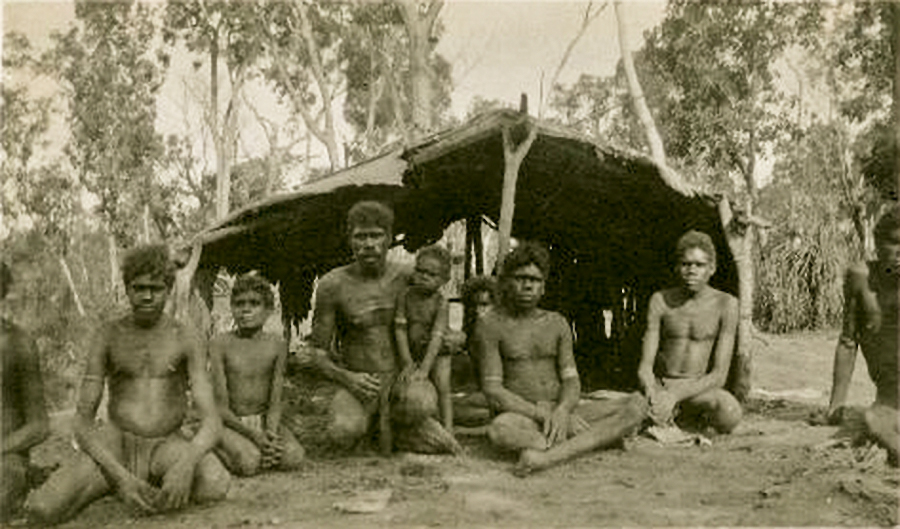 |
| Aboriginal boys and men in front of a bush shelter. |
 |
| Dog Rock, Albany, 1937 |
Later, after the
arrival of the British, Major Lockyer of the Frederick Town (later Albany garrison) interviewed two sealers, who were arrested for crimes against the Menang Noongar people. He also reported incidents of Aboriginal women being found on Michaelmas island, kidnapped and then, abandoned by the sealers.
A man named Nebinyan, who was born at Two Peoples
Bay around 1840, performed a song cycle for the ethnographer Daisy Bates in
1908. Nebinyan had worked for many years as part of the
crew on a whaling ship and he talked about these experiences during their conversations. Sadly,
Bates
conveyed little about the contents
of Nebinyan's songs, but what she did write down hinted at the negotiation,
participation and collaboration between the British and Aboriginal groups of
this area.
 |
| Aboriginal people who lived around Albany in the 1880s, Western Mail (Perth, WA : 1885 - 1954), Thursday 30 March 1939 |
 |
| "Tommy King, chief of the Albany, natives in the carly days of the settlement of the district", Western Mail (Perth, WA : 1885 - 1954), Thursday 14 March 1940 |
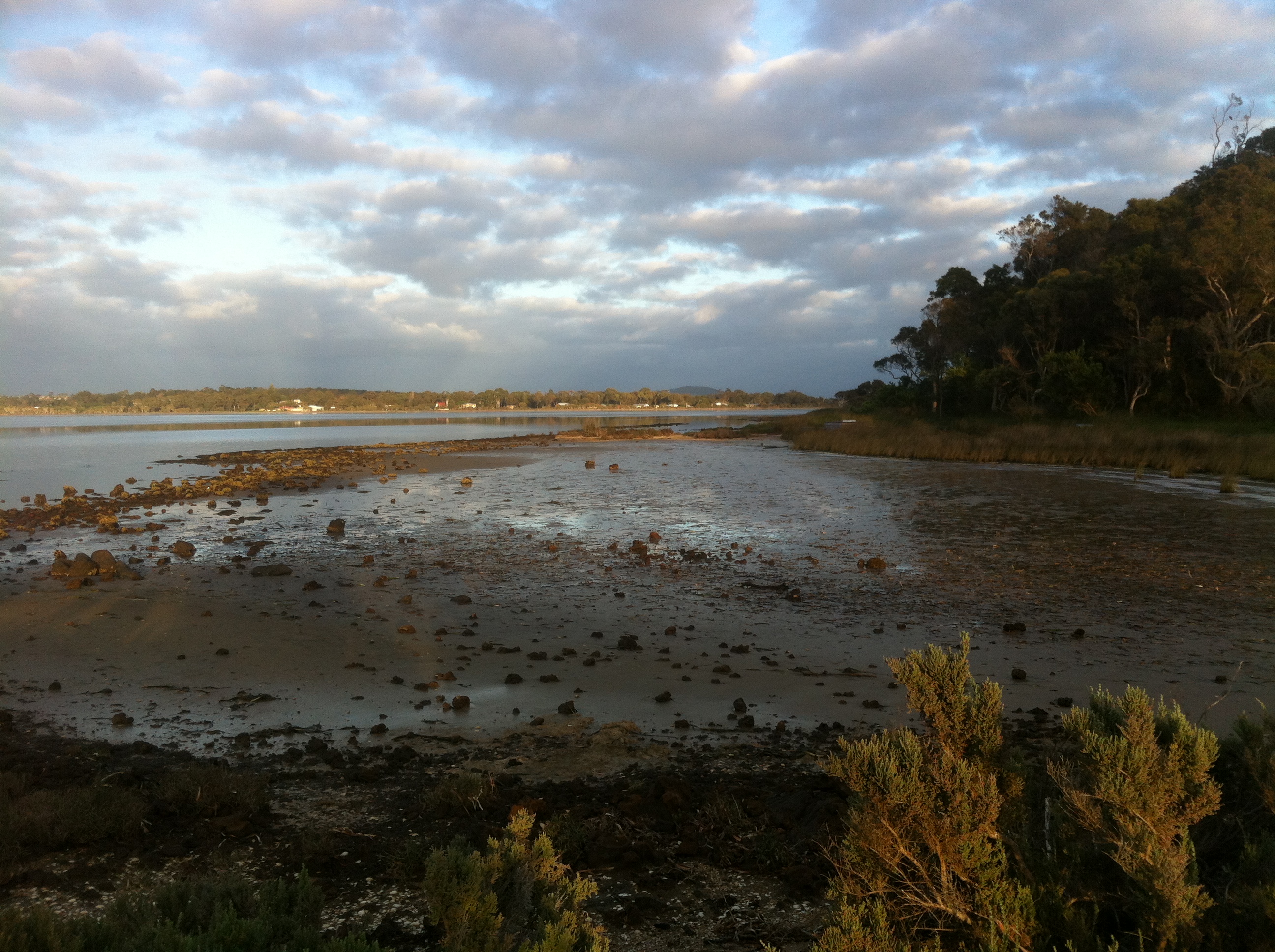 |
| The Albany Fish Traps, approximately 14 kilometres (9 mi) east of Albany, are over 7,500 years old |
The coastline of the Albany area was first observed by Europeans in 1627, when the Dutch ship "Gulden Zeepaert" (Golden Seahorse), with Captain François Thijssen and merchant Peter Nuyts onboard, mapped more than 1,500km of coastline from Albany, WA, to Ceduna, SA.
 |
| The Gulden Zeepaert (Golden Seahorse) sailed from the Netherlands on 22 May 1626, under the command of Francois Thijssen. Map of the Malay Archipelago and Australia by Hessel Gerritsz, 1628-32 |
Commander George Vancouver, RN, sailing on the "Discovery", visited and named The Princess Royal Harbour and
the broader area, King George Sound, after King George III, when he visited in On 29 September 1791. He claimed, "possession of the country", for England.
 |
| Captain George Vancouver, n.d. |
In 1792, the French naval officer and explorer, Antoine de Bruni d'Entrecasteaux, reached Cape Leeuwin but high winds stopped the vessel from entering King George Sound (Albany), so the expedition continued along the south coast.
In 1801 Englishman, Matthew Flinders entered King George Sound on the "Investigator" and stayed for about a month before charting the rest of the southern Australian coastline.
Nicolas Baudin arrived in the Albany area in February 1803 aboard "Le Geographe" and met with Louis de Freycinet aboard the "Casuarina", before further exploring the Western Australian coastline.
In 1818, aboard the cutter "HMS Mermaid", Phillip Parker King visited the area.
In 1826, Frenchman Dumont d'Urville sailing the "L'Astrolabe", visited King George Sound. The artist, Louis-Auguste de Sainson made a drawing of Noongar Aboriginal man named Mokare, who is credited with later helping the British and enabling harmony between the various groups (more below).
Aboriginal people generally appeared to believe that the British were the returned spirits of their dead, ancestors (Djanga). Some Noongar people later called European settlers "Wetjala", derived from the English term "white fella".
There are hundreds of shipwrecks along the coast of Western Australia, which wrecked mostly due to treacherous reefs and winds. Many whalers and sealers and explorers also, managed to visit the Albany area before
European settlement.
The First European Settlement of Western Australia
_Westall.jpg) |
| Pencil wash of King George George Sound (1801) in Western Australia.
By William Westall |
Albany was established as a military outpost of New South Wales after the British learned that several
French ships had been sighted off the southwestern coast.
An expedition set off in the brig, "Amity", with great haste from Sydney battling the strong winds and currents of Bass Strait and the Southern Ocean, landing at Albany on Christmas Day 1826.
The European settlement of the region, under Major Edmund Lockyer, was set between rolling green hills and the waters of King George Sound. British troops and convicts were the first settlers.
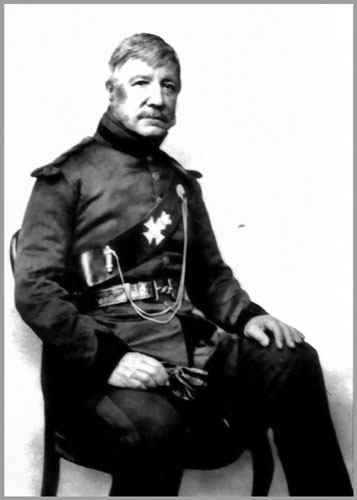 |
| Edmund Lockyer in uniform of Captain of the Sydney Volunteer Rifle Corps |
 |
| A replica of the ship "Amity", Albany, WA |
Farming
The Old Farm in Strawberry Hill, at Mira Mar, a suburb of Albany, was established in 1827 as a government farm. Alexander Collie, the Government Resident of Albany in 1831, named the farm after the plot of strawberries that he
was growing there. Richard Spencer, who was the Government Resident in 1833, had a granite two-storey farmhouse built. Charles Darwin stayed at this house when he visited.
 |
| Strawberry Hill Farm, Albany, WA, the oldest farm in Western Australia, established even before the Swan River Colony. ND |
Albany was initially named Frederick’s Town in honour of the brother of King George III, but the settlement was called Albany by 1831.
 |
| Western Mail (Perth, WA : 1885 - 1954), Thursday 9 July 1936 |
Explorer and soldier, Thomas Banister, lead an expedition from Perth to Albany in 1830-1.
Albany's official postal service began on October 14, 1834, with Sarah Lyttelton as the honorary postmistress. Various roughly constructed, government buildings, were
located around the area now called Lawley Park, in the early years of the colony.
The number of settlers increased after 1835, when Governor Stirling and the Surveyor-General, John Septimus Roe explored t
he surrounding country, with the idea of creating a road, between Perth and Albany.
Mokare
Mokare, a Noongar Aboriginal man, was very helpful to the Europeans in the early days of the Albany settlement, by showing them the Aboriginal tracks in the area, and by being a helpful mediator between the Aboriginal people and the British.
Mokare lived with government resident, Dr Alexander Collie, whist in Albany, and he was a good friend of the surgeon-assistant, J. S. Nind. When Mokare died, John Septimus Roe had Mokare buried at the new Albany Cemetery. When Collie was dying from tuberculosis in 1835, he asked to be buried alongside Mokare.
 |
| Mokare Portrait by Louis de Sainson 1833 |
Stirling Terrace, named after the first governor of WA, Captain James Stirling, had appeared on maps of the town since 1834 and was set down in the 1835 Hillman survey plan as the Main Street. Glasgow House and Edinburgh House were built by Alexander Moir, whose home, once stood where The Royal George Hotel now stands. Three of the four original hotels still exist today.
 |
| Stirling-terrace from lower Spencer-street as it appeared'in 1877 Many of the commercial buildings have since been replaced. Western Mail (Perth, WA : 1885 - 1954), Thursday 30 March 1939 |
Charles Darwin
Charles Darwin visited Albany aboard the "HMS Beagle" in 1836 and declared it, "....so uninviting a country". Darwin did not realise that the infertile looking
landscape of stunted trees was actually, much older and more biologically diverse than many of the places that he had studied with much interest.
Albany's first town jetty was built in about 1837. Then new jetty was built between 1862 and 1864. Albany was preferred as a port to Fremantle, at this time, as Fremantle was exposed to dangerous winds.
Edward John Eyre, wanting to "discover the inland of Australia", travelled with his Aboriginal companion, Wylie, overland on an almost 2000 mile trip to Albany. Others had accompanied them, but one member was murdered and the rest disappeared.
Henry Camfield was appointed Resident Magistrate in 1847, when Albany had a European population of about 250 people. Camfield House (or Annesfield), was constructed in 1852, for Henry Camfield and this wife, Anne, who, along with the chaplain, John Ramsden Wollaston and a grant from Governor Fitzgerald, began a school for Aboriginal children. A purpose built schoolhouse was built in 1858.
 |
| Anne Camfield and Bessie Flower, 2 January 1865. Bessie Flower was a Minang Noongar woman who was educated at Annesfield, and developed a strong connection to headmistress Anne Camfield. Throughout her life she fought for Aboriginal rights and to keep families together |
The Mail Centre
In 1852 Albany became the mail port for Western Australia.
The mail coach in 1853, took 4½ days to travel to Perth, but by the following year,
travelled the route in 3½ days.
 |
| The departure of the last mail coach from Albany before the Great Southern railway was opened in 1889. Western Mail (Perth, WA : 1885 - 1954), Thursday 5 January 1933 |
The Albany Convict Gaol was established in 1852, for British convicts who were transported to Albany as skilled labourers. The oldest parts of the gaol were built for male convicts in 1852 and women's quarters were added between 1872 and 1875. Unlike the convict system in New South Wales and
Tasmania, the Albany convict system was based on rehabilitation and convicts were hired out as farm labour, mostly to free settlers.
By the 1850s, the Port of Albany was being visited by a vast array of shipping and whaling stations were soon being established. Interestingly, Frenchman Bay whaling station only ceased its operations in 1978.
A government primary school existed at Albany since 1861.
 |
| Students outside Albany State School, Albany Wa, circa 1880, SLWA |
By 1880, the police had taken over the mail service and the change of horses took place at police stations, with prisoners caring for, and feeding the horses. The last mail coach to travel from Albany to Perth was in 1888.
By1854, bridges had been constructed over all the rivers between Perth and Albany and a road cleared as far as the Gordon River.
In 1867, after prolonged negotiations with the Perth administration, Government Resident Sir Alexander Cockburn-Campbell succeeded in his request for a government office building, to include a post office, courthouse, municipal and road board meeting rooms and a customs house. The original post office building was completed in 1869, with excavations using convict labour. The second
phase of construction was completed in 1895.
On December 26, 1871, a telegraph service to Perth was established. And in 1875, the first pole for an overseas telegraph line was placed outside the post office. The Albany to Adelaide telegraph began construction in 1875 following the path made by Edward Eyre 34 years earlier. The telegraph was a great achievement of infrastructure and cooperation and Albany was linked to the rest of the country and indeed, the world.
Forging Ahead
The construction of the Great Southern rail line from Beverley to Albany began in 1888. And t
he Town Hall was built in the same year.
 |
| Albany Town Hall under construction, circa 1888, SLWA |
The fort at Albany opened in 1893 in response to perceived threats from foreign powers. This fort only ever operated for defence and as a deterrent. Today called the Princess Royal Fortress.
1893 saw the beginning of the gold rush in Western Australia, as
thousands of hopeful diggers flooded into Albany eager to get to the Eastern Goldfields, after gold nuggets were discovered in Coolgardie. 500 migrants per week were arriving in the port of Albany and there were seven major steamship companies in the town.
_p091_ALBANY%2C_WESTERN_AUSTRALIA.jpg) |
| Albany Western Australia, 1892 |
 |
| "Governor" Durea is probably the oldest Aboriginal in the Eastern Districts. Settlers state that he must be over 90 years of age. He is described as above the average height, and he has a fine intelligent bearing and a striking resemblance to a late great Australian statesman.Western Mail (Perth, WA : 1885 - 1954), Friday 16 December 1898 |
 |
| Stirling Terrace, Albany, 1908 |
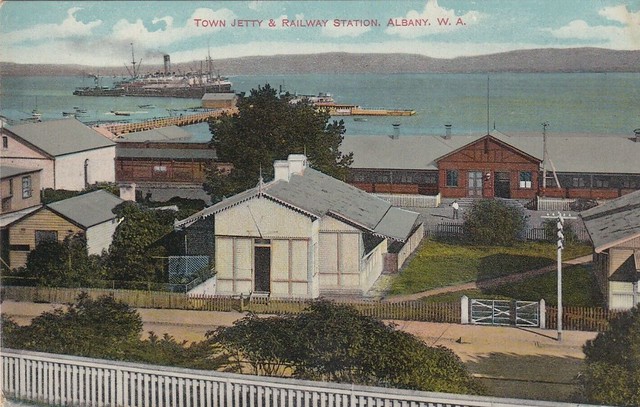 |
| Town Jetty and Railway Station in Albany, W.A. - early 1900s, Aussie~mobs |
 |
| Aboriginal people, - Albany, Western Australia - very early 1900s, Kaye |
Albany Picture Gardens and Skating Rink
 |
| Albany Ladies Roller Hockey Team, ca. 1907, SLWA |
Albany Picture Gardens and Skaing rink was operating in the Cremorne Gardens, behind the Royal George Hotel in 1910-11.
 |
| Albany Advertiser (WA : 1897 - 1954), Wednesday 25 January 1911 |
 |
| Postcard featuring a sepia toned photograph of two Aboriginal women and a child, Albany WA, circa 1910 |
 |
| Stirling Terrace, Albany, 1912 |
At War
After Fremantle Harbour opened for shipping in 1897, Albany diminished in importance. But Albany would some years later, be the last
sight of the Australian land that the ANZAC soldiers would see, before setting off to fight for the Allies during the First World War.
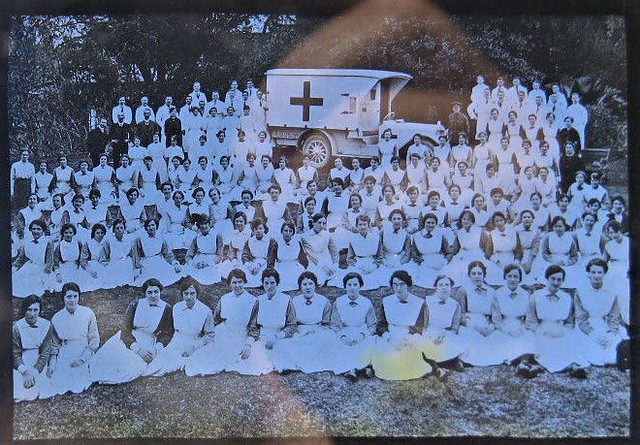 |
| WW1 Australian nurses and doctors with ambulance, Group awaiting departure from Albany, Western Australia, Aussie~mobs |
 |
| The Rocks in Albany has been used as accommodation for returned servicemen, after WW1 |
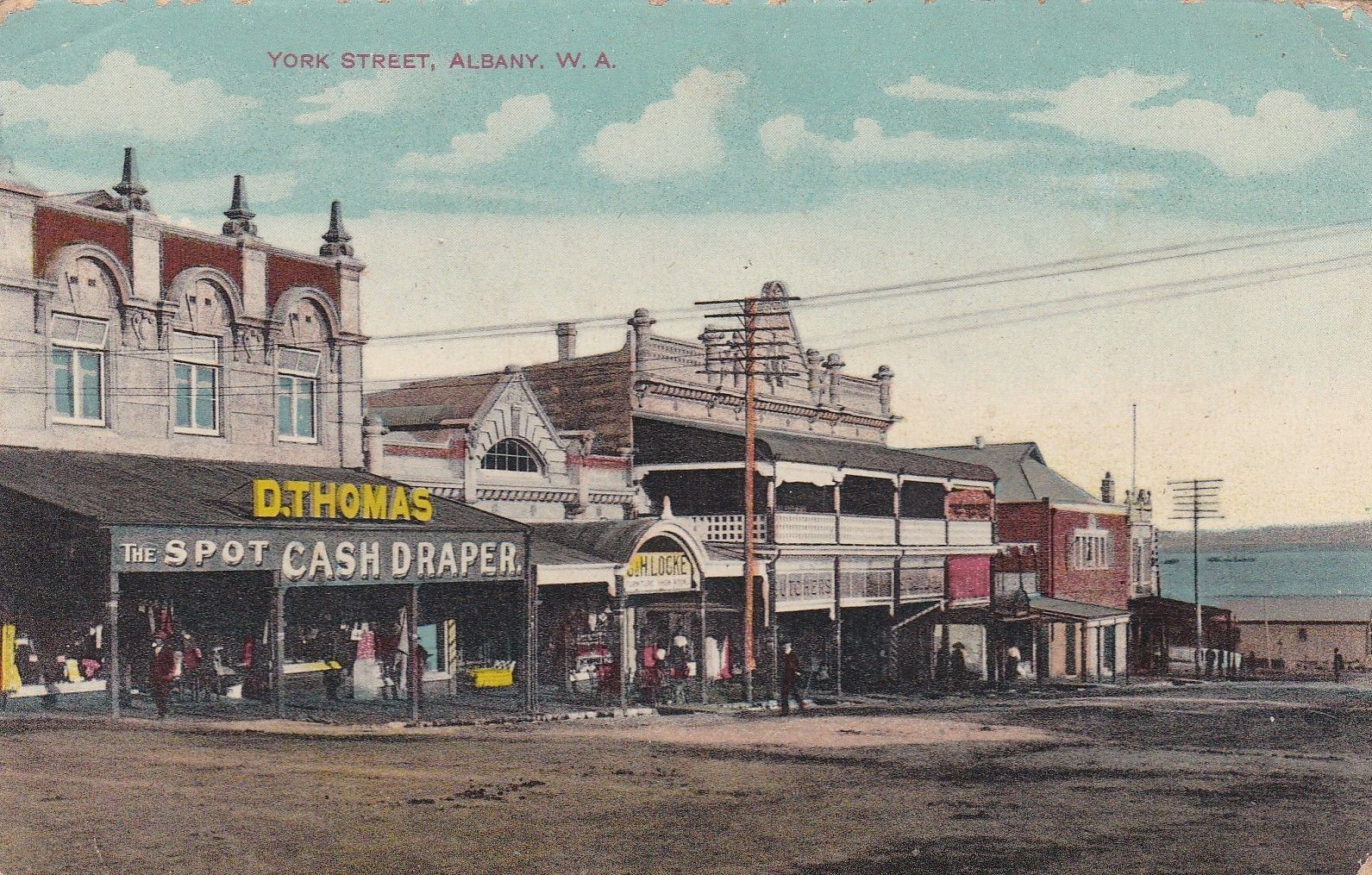 |
| York Street, Albany, Western Australia |
 |
| Boys on bicycles, date unknown |
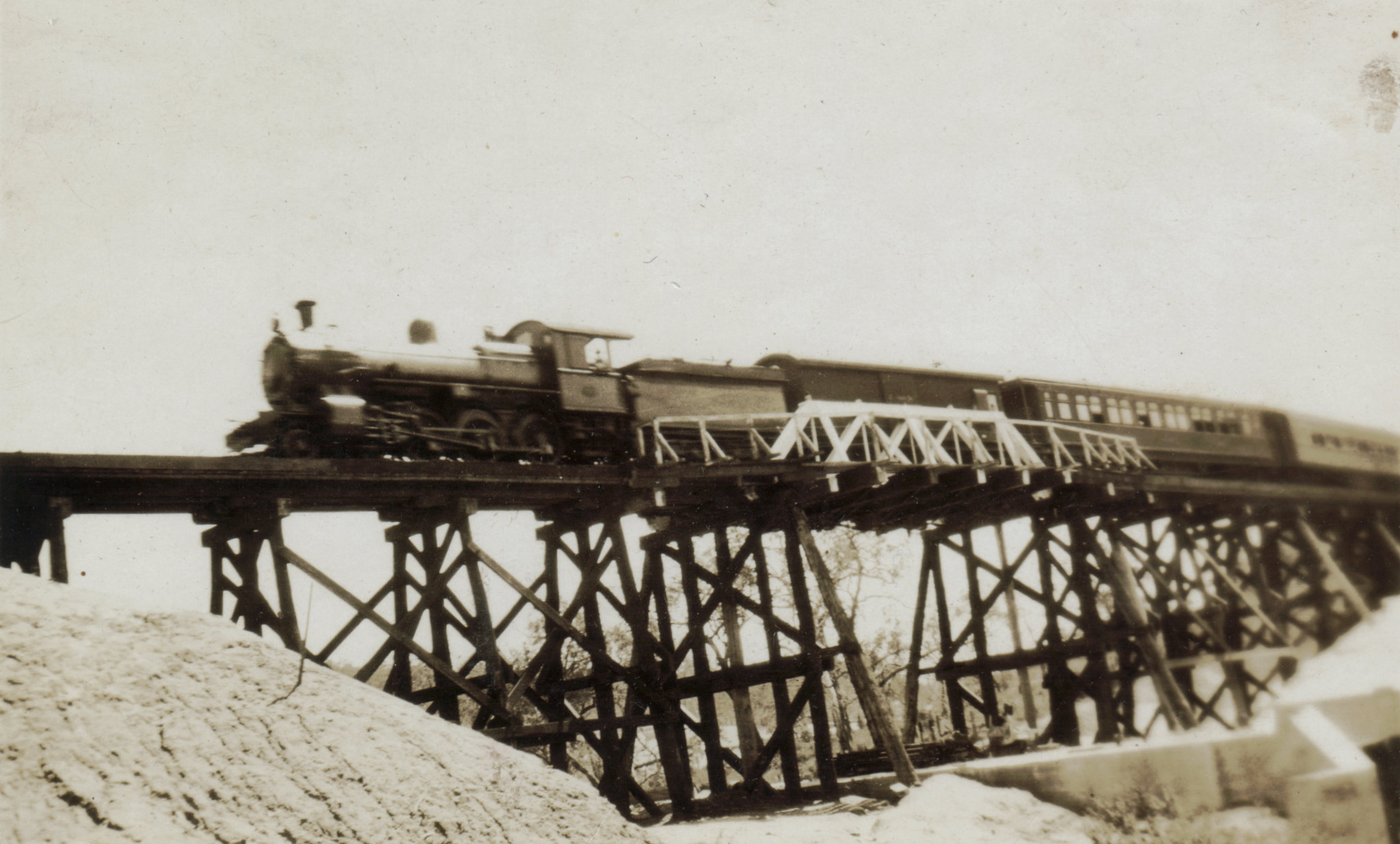 |
| Train from Albany crossing bridge, December 1925, Donna Barber |
 |
| Wandinyilmernung, an Aboriginal man from the Albany area, WA, Western Mail (Perth, WA : 1885 - 1954), Thursday 25 December 1924 |
 |
| Western Mail (Perth, WA : 1885 - 1954), Thursday 27 February 1936 |
 |
| Western Mail (Perth, WA : 1885 - 1954), Thursday 27 February 1936 |
 |
| Mount Barker and Denmark Record (Albany, WA : 1929 - 1949), Thursday 5 December 1946 |
Change and Diversity
Albany Post Office moved to York Street in 1964 and Stirling Terrace began to decline as a street of importance, as York Street became the town centre.
 |
| Aboriginal hunting tools. In 2016, 14 historical artefacts collected by the British during the establishment of the town of Albany, WA, in the 1800s, were returned. These artefacts had been stored at the British Museum for the past 180 years. Some of these items include stone axes, spears, and knives |
Around Albany
 |
| Glasgow House and Edinburgh House on Stirling Terrace Albany, WA, (Hughesdarren ) Glasgow House was built for Alexander Moir, along with Edinburgh House, in 1882, Albany, WA |
 |
| Naval gun at Princess Royal Fortress, Albany, WA |
 |
| Albany Heritage Park.Princess Royal Fortress the living quarters, circa 1899, Albany, WA |
 |
| Former Drew Robinson & Company building, 82-84 Stirling Terrace Albany, constructed from 1880. Constructed in 1880 and was originally owned by the McKail family, Albany, WA |
 |
| Albany, WA, Convict Gaol opened in 1854, Albany, WA |
 |
| Replica of the brig, Amity, Albany, WA |
 |
| Former Government House or Government Cottage was constructed in 1882, Albany, WA |
 |
| Princess Royal Fortress named in 1791, Albany, WA |
 |
| Former Albany Cottage Hospital was built in 1887, Albany, WA |
 |
| Old Albany Courthouse, constructed 1896-1898 |
 |
| Old Albany Post Office, built around 1870, Albany, WA |
 |
| The Empire Buildings were constructed in 1912, Albany, WA |
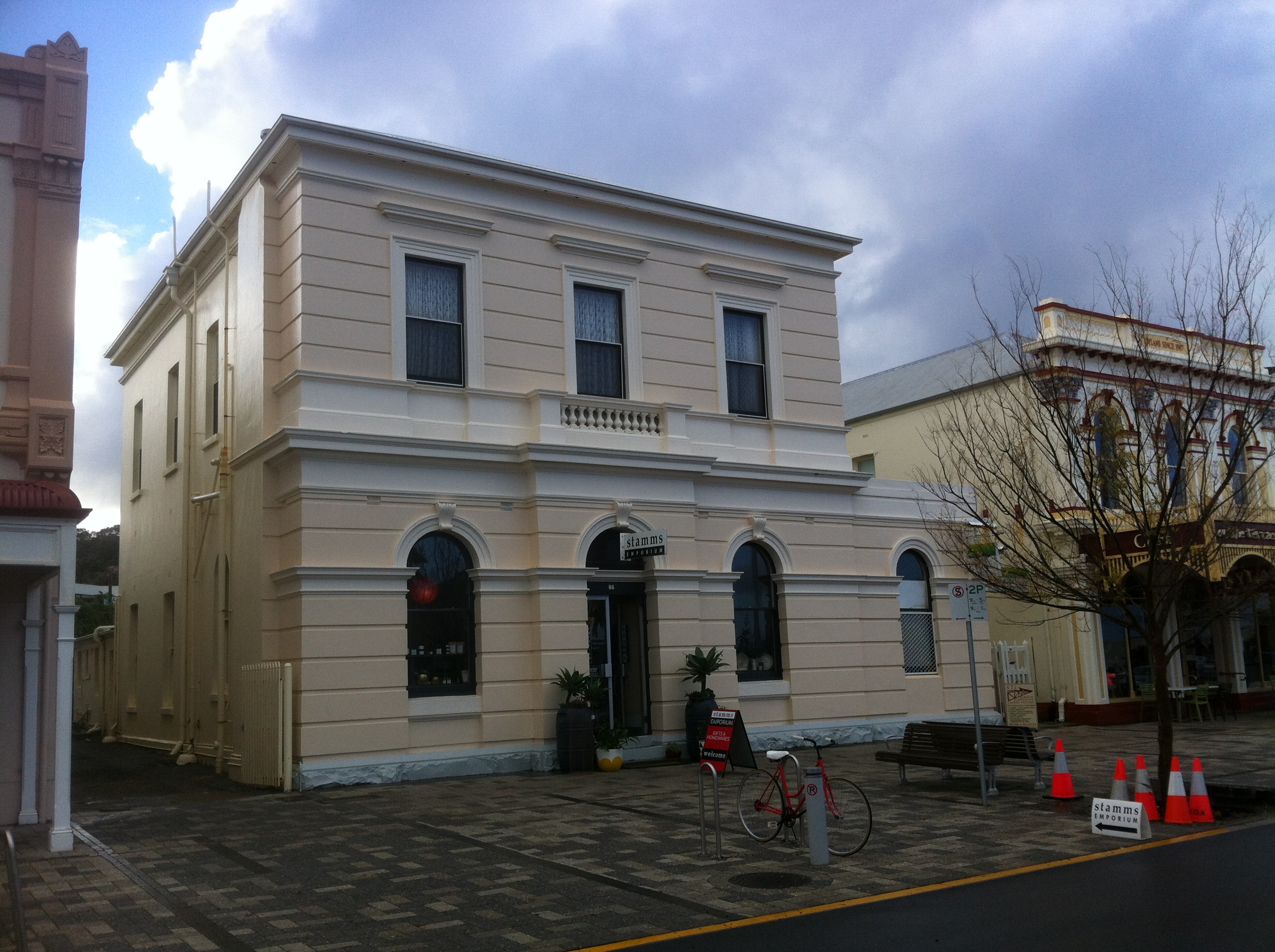 |
| Vancouver House was constructed in 1881, Albany, WA |
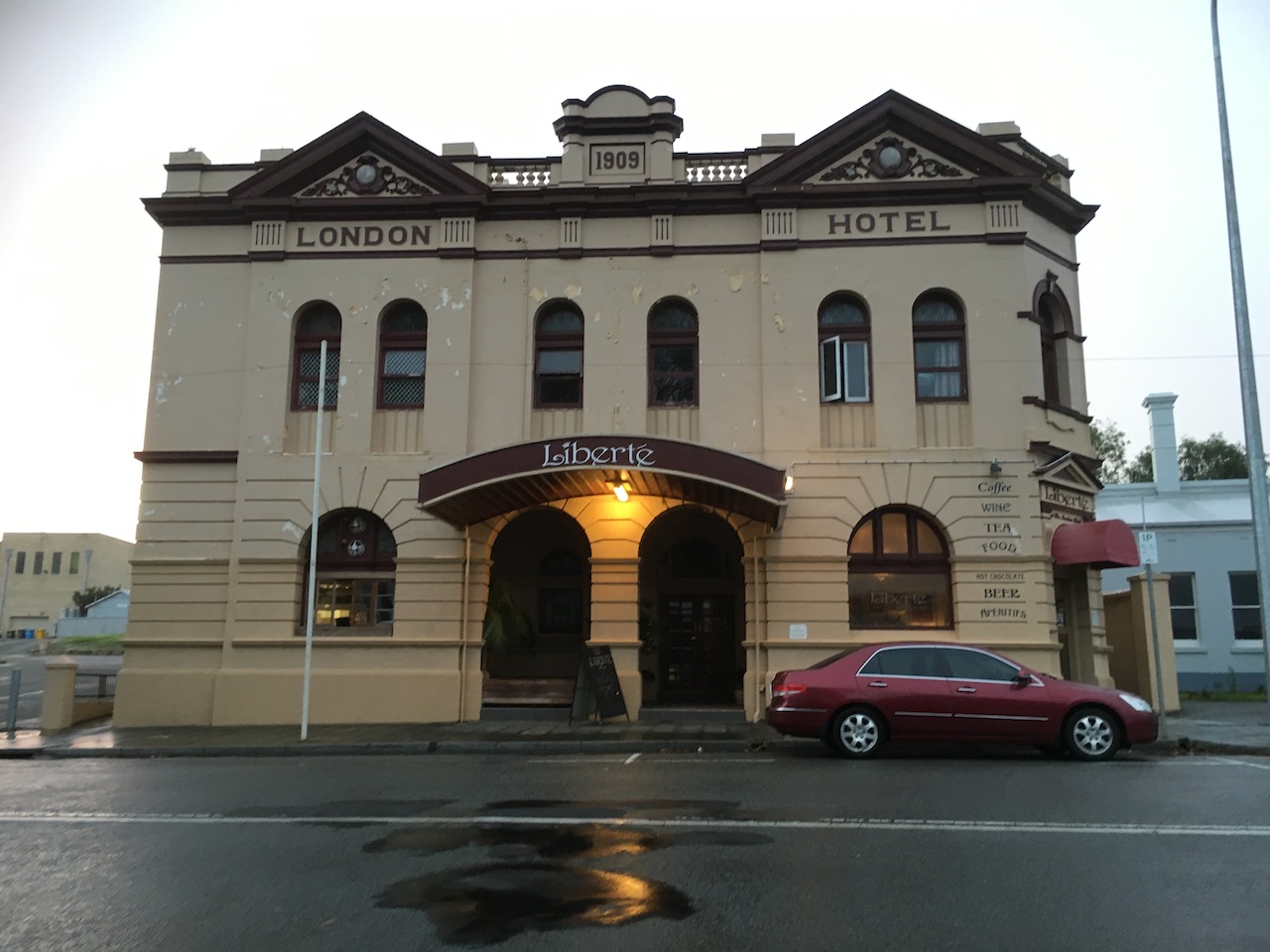 |
| The London Hotel is a hotel located on Stirling Terrace built in 1909, Albany, WA |
 |
| Pyrmont House, Albany, was established in 1858, Albany, WA |
 |
| Albany Woollen Mills, circa 1923, Albany, WA |
 |
| The Old Farm is located on Strawberry Hill, Albany, WA, initially established in 1827 |
 |
| Patrick Taylor Cottage is ocated below road level on Duke Street overlooking Princess Royal Harbour, dates back to when the town was a military outpost, circa 1832. he wattle and daub construction is representative of the traditional building methods used by the early settlers. Hughesdarren, Albany, WA |
 |
| Albany Convict Gaol Museum, built 1852, Albany WA |
 |
| Replica of death mask of mass murderer Deeming by Mrs Alice Wimbush. Date: 1892. At Albany Convict Gaol Museum |
 |
| London Hotel on the left and Albany House on the right, Albany, WA.(JarrahTree.), Albany, WA |
 |
| Albany, WA |
 |
| Albany House from York Street, Albany WA (Hughesdarren). The building was originally constructed as the Union Bank of Australia building, and completed in 1884 |
 |
| Albany Masonic Hall main facade, Albany, WA, (Hughesdarren). The first hall was built on the site in 1873 but was demolished in 1903 to make way for the new hall, Albany, WA |
 |
| View of Camfield House from the north (Hughesdarren), Albany, WA. The property contains a wattle and daub house constructed in 1852 as a residence for the Camfields that was also known as Annesfield. |
 |
| Old Post Office, south front, Albany, WA. (Iwelam). The original building was completed in 1869. The second phase of construction was completed in 1895 |
 |
| Everett Building Albany, WA, located on the corner of Stirling Terrace and Spencer Street almost directly opposite the Old Post Office building, constructed from 1880 |
 |
| York Street, Albany, WA (Nachoman-au ) |
 |
| Pyrmont House, is a residence located on Serpentine Road in Albany, WA, circa 1858 |
Things To Do and Places to Go
Albany's Historic Whaling Station
The Museum of the Great Southern, Albany
Walk and discover Amazing Albany. A guide to Albany’s spectacular walks for all ages
Brig Amity
The Old Gaol and Museum
Patrick Taylor Cottage Museum
Newcastle Gaol Museum Precinct
Princess Royal Fortress Military Museum
Albany Heritage Park
Early Mail Services in the South-West of WA (1829-1901)
Novels Set in Western Australia
Cloudstreet (1991), by Australian writer Tim Winton.
Coonardoo: The Well in the Shadow (1928), by the Australian author Katharine Susannah Prichard.
The Light Between Oceans (2012) Australian historical fiction novel by M. L. Stedman.






_Westall.jpg)









_p091_ALBANY%2C_WESTERN_AUSTRALIA.jpg)









































